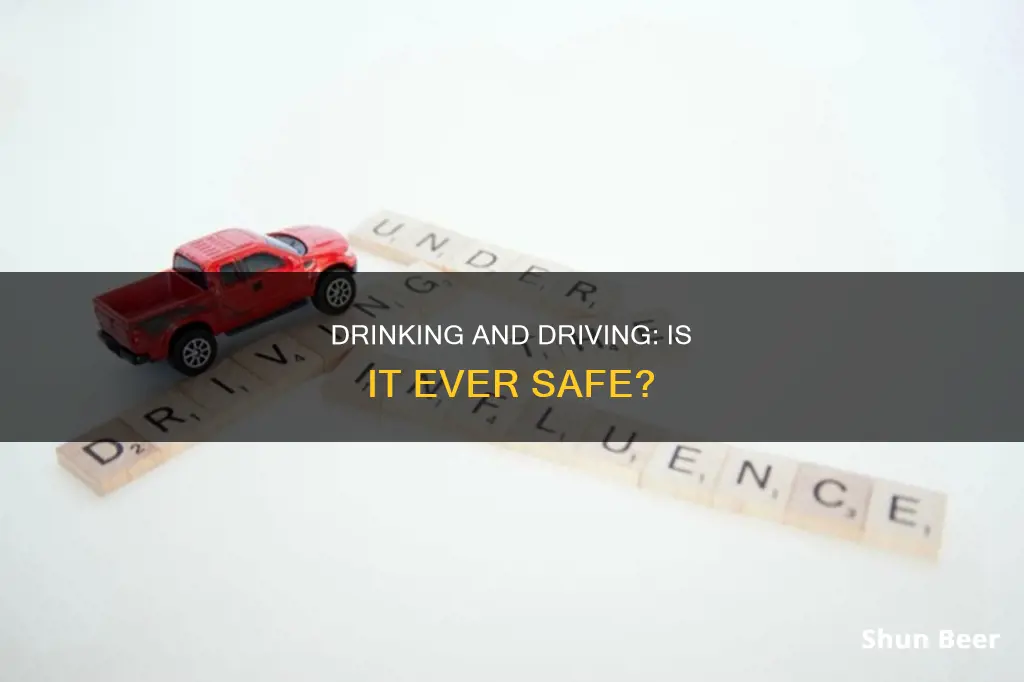
Drinking and driving is a serious issue that can lead to devastating consequences, including injuries and fatalities. While the legal limit for blood alcohol content (BAC) while driving is typically .08%, various factors, such as weight, gender, metabolic rate, and food consumption, influence how alcohol is processed by the body. As a result, it is challenging to provide a definitive answer to the question, Can you drink 3 beers and drive? The safest option is to refrain from driving after consuming any amount of alcohol and to utilize alternative transportation methods.
| Characteristics | Values |
|---|---|
| Number of Beers | 3 |
| Time Taken | 1 hour |
| Weight of Man | 180 lbs |
| Weight of Woman | 140 lbs |
| ABV of Beer | 5% |
| BAC Limit | 0.08% |
| Man's BAC | 3.5 beers in 1 hour to keep BAC under 0.08% |
| Woman's BAC | 2.5 beers in 1 hour to keep BAC under 0.08% |
| Contributing Factors to BAC | Individual's metabolic rate |
| Tolerance | |
| Food consumption | |
| Water intake |
What You'll Learn

Weight, tolerance, food and water intake matter
An individual's weight plays a significant role in determining their Blood Alcohol Concentration (BAC). For instance, a 180-lb man may be able to consume 3.5 regular 12-ounce beers in an hour and maintain a BAC under the legal limit of 0.08%. On the other hand, a 140-lb woman may only be able to drink 2.5 beers within the same time frame and stay within the legal limit.
Tolerance to alcohol also varies from person to person. Some individuals may have a higher tolerance due to various factors, such as their metabolic rate or previous alcohol consumption patterns. Those with a higher tolerance may be able to consume more alcohol before reaching the legal BAC limit.
Food and water intake can also influence BAC levels. Consuming alcohol on a full stomach or alternating alcoholic drinks with water can slow down the absorption of alcohol into the bloodstream. This can result in lower BAC levels compared to drinking on an empty stomach or without adequate hydration.
It is important to note that these factors do not provide a definitive answer to the question of how many beers one can drink before driving. The effects of alcohol vary from person to person, and the only way to ensure complete safety is to refrain from drinking altogether if driving. The legal limit for BAC may vary depending on the country and the specific circumstances, such as the driver's age or profession.
Additionally, alcohol affects cognitive functions, including multitasking abilities, which are crucial for driving. Even a small amount of alcohol can impair an individual's reaction time and increase the risk of accidents. Therefore, it is generally recommended to avoid drinking altogether if driving and to plan alternative transportation arrangements if alcohol consumption is intended.
Drinking Non-Alcoholic Beer While on Plavix: Is It Safe?
You may want to see also

ABV levels vary in different beers
Whether or not you can drink three beers and drive depends on a variety of factors, including weight, tolerance, food consumption, water intake, and the size and strength of the beers.
In the United States, a standard drink is defined as approximately 14 grams of pure alcohol, which is typically found in a 12-ounce beer with 5% alcohol by volume (ABV). However, it's important to note that the ABV can vary significantly among different beers.
Light beers typically have an ABV ranging from 1.2% to 5%, with popular brands like Bud Light, Coors Light, and Miller Lite falling around 4.2%. Medium beers have an ABV ranging from 5% to 8%, and strong beers start at 8% ABV and can go as high as 15% or even higher for specialty beers.
For example, popular beer brands with an ABV above 5% include Blue Moon (5.4%), Budweiser (5%), Heineken (5%), and Corona Extra (4.6%). Some craft IPAs, stouts, and ales may also have higher ABV levels. On the other hand, there are also non-alcoholic beers available that contain little to no alcohol.
The varying ABV levels in different beers can significantly impact an individual's Blood Alcohol Concentration (BAC) when consumed in the same quantity. Therefore, it is crucial to be aware of the ABV levels in the beers you are drinking and to always drink responsibly.
Beer and Driving: Safe After One?
You may want to see also

Legal limit in the US is .08
The legal blood alcohol concentration (BAC) limit in the US is .08%. This means that if your BAC is above this level, you are presumed to be too intoxicated to drive. This is known as DUI per se, which means that your BAC speaks for itself and is enough to show that you were too drunk to be behind the wheel.
The limit was established in 1998 when President Bill Clinton took the initiative to standardise the definition of legal intoxication across the country. Before this, the limit varied from state to state.
It's important to note that the number of drinks it takes to reach the .08% limit can vary depending on several factors, including gender, weight, and the amount of time since the last drink. For example, a 180-lb man may be able to drink 3.5 regular 12-ounce beers in one hour and keep his BAC under the legal limit, while a 140-lb woman may only be able to consume 2.5 beers in an hour and maintain a BAC below .08%.
Additionally, the BAC limit for drivers under 21 years old is typically lower, ranging from 0.00 to 0.02. There are also lower BAC limits for operating boats, airplanes, or commercial vehicles, with a limit of 0.04% for commercial drivers.
It's always best to err on the side of caution and avoid drinking and driving altogether. There are many factors that can affect your BAC, and it's difficult to know exactly when you've reached the legal limit.
Beer After Best Before Date: Is It Safe to Drink?
You may want to see also

Metabolising alcohol
Absorption of Alcohol
Alcohol is not digested like food. After consumption, a small amount of alcohol is absorbed directly by the tongue and mucosal lining of the mouth. In the stomach, alcohol is rapidly absorbed into the bloodstream through the tissue lining. The presence of food in the stomach can slow down alcohol absorption by physically obstructing its contact with the stomach lining and delaying its passage into the small intestine.
Distribution of Alcohol in the Body
Once alcohol enters the bloodstream, it reaches all organs, including the brain, within 90 seconds. Alcohol can penetrate approximately 68% of body tissues in adult males, except bone and fat. Body composition plays a role, as a higher percentage of adipose tissue results in a higher concentration of alcohol in the remaining lean tissue.
Factors Affecting Alcohol Absorption
The rate of alcohol absorption depends on several factors, including the concentration of alcohol, blood flow at the site of absorption, and the irritant properties of alcohol. Alcohol crosses biological membranes through passive diffusion, and higher concentrations create a greater concentration gradient, leading to faster absorption. Efficient blood flow helps maintain the concentration gradient and promotes absorption.
First Pass Metabolism in the Stomach
Some ingested alcohol undergoes first pass metabolism in the stomach, where it is oxidised by alcohol dehydrogenase (ADH) isoforms. This process modulates alcohol toxicity by determining the bioavailability of alcohol. The efficiency of first pass metabolism varies and may be lower in alcoholics, especially alcoholic women, due to decreased ADH activity.
Alcohol Metabolism in the Liver
The liver is the primary organ responsible for alcohol detoxification. It contains the major enzyme systems that metabolise alcohol, particularly alcohol dehydrogenase (ADH) and, to a lesser extent, the cytochrome P450-dependent ethanol-oxidising system. ADH oxidises alcohol into acetaldehyde, a highly toxic compound and known carcinogen. Subsequently, aldehyde dehydrogenase (ALDH) further metabolises acetaldehyde into acetate, a less toxic compound. Finally, acetate is broken down into carbon dioxide and water, mainly in tissues other than the liver.
Factors Influencing Alcohol Metabolism
Alcohol metabolism is influenced by genetic and environmental factors. Genetic variations in the enzymes that break down alcohol, such as ADH and ALDH, play a significant role. Additionally, environmental factors like the amount of alcohol consumed and overall nutrition can impact metabolism.
Other Pathways of Alcohol Metabolism
While the liver is the primary site of alcohol metabolism, small amounts of alcohol are also metabolised in other tissues, including the pancreas, brain, and gastrointestinal tract. Catalase and CYP2E1 enzymes in these tissues can oxidise alcohol into acetaldehyde, but their contribution is generally minor.
Elimination of Alcohol and Its Metabolites
Approximately 90% of alcohol is eliminated from the body through oxidation. Ten percent is excreted through breath, sweat, and urine. Alcohol is volatile and can be eliminated through breath when it comes in contact with air in the alveoli of the lungs. The remaining alcohol and its metabolites, such as acetaldehyde and acetate, are eliminated through urine and sweat.
Beer and Prozac: Safe Mix or Risky Business?
You may want to see also

Gender differences
Whether or not it is safe to drive after drinking three beers depends on a variety of factors, including body weight, height, tolerance, food and water consumption, and the size and strength of the beers. However, it is important to note that drinking any amount of alcohol can impair an individual's reaction time and judgment, and it is generally recommended to avoid driving after consuming alcohol.
When it comes to gender differences, research has shown that males and females differ in their ability to metabolize alcohol due to variations in the amount and activity of alcohol dehydrogenase (ADH), the enzyme responsible for metabolizing alcohol. Males tend to have higher levels of active ADH in their stomach and liver, which can reduce alcohol absorption by up to 30%. On the other hand, females have lower levels of ADH in their stomachs and less active ADH in their livers, resulting in higher blood alcohol concentrations (BACs) compared to males when consuming the same amount of alcohol. This means that for the same number of drinks, females can become intoxicated more easily.
These differences in alcohol metabolism can have significant implications for driving ability. Studies have shown that moderate alcohol consumption can impair cognitive functions such as divided attention, information processing, reaction time, and memory, as well as psychomotor performance tasks such as eye-brain-hand coordination and body sway. While psychomotor performance does not appear to be affected by gender, females may be more susceptible to alcohol-related cognitive impairments. Additionally, females may be more susceptible to the long-term health effects of alcohol, such as alcoholic liver disease.
It is important to note that other factors, such as body composition and total body water content, also play a role in alcohol absorption and metabolism. Females tend to have proportionally more body fat and less water than males of the same body weight, which can contribute to higher peak BACs in females even when doses are adjusted for body weight.
In summary, while the effects of drinking three beers on driving ability can vary depending on a range of factors, it is important to consider the potential risks and impairments associated with alcohol consumption, especially when operating a motor vehicle. The safest option is to avoid drinking and driving altogether.
Carrying a Concealed Weapon and Drinking Beer in Virginia
You may want to see also
Frequently asked questions
It depends on a lot of factors, including your weight, gender, metabolic rate, and the ABV of the beer. Generally, it's recommended that you don't drive after drinking any amount of alcohol.
In the United States, the legal limit for blood alcohol content (BAC) while driving is .08. If you're found to be driving with a BAC of .08 or higher, you can be arrested for driving under the influence (DUI).
This depends on various factors, including your weight, gender, and the ABV of the beer. As a general estimate, an 180-lb man may be able to drink 3.5 regular 12-ounce beers in an hour and stay under the legal limit, while a 140-lb woman may be able to consume 2.5 regular beers in an hour and maintain a BAC below .08%. However, these numbers are just estimates and can vary significantly based on individual factors.
Alcohol can impair your judgment, slow your reaction times, blur your vision, and increase your willingness to take risks. Even a small amount of alcohol can affect your ability to drive safely, and it's essential to refrain from driving if you've been drinking.
Drinking and driving is extremely dangerous and can lead to devastating consequences. It can result in injuries, disabilities, and even death for yourself and others. It's crucial to understand the risks and never drink and drive.







